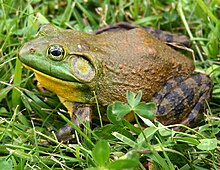
Back Rana catesbeiana AN ضفدع الثور Arabic ضفدع الثور ARZ Жаба-бык Byelorussian Жаба бик Bulgarian Ran-darv Amerika Breton Granota toro Catalan Lithobates catesbeianus CEB Skokan volský Czech Шапа-вăкăр CV
| American bullfrog Temporal range: Middle Miocene - Recent
| |
|---|---|

| |
| Adult male | |
| Scientific classification | |
| Domain: | Eukaryota |
| Kingdom: | Animalia |
| Phylum: | Chordata |
| Class: | Amphibia |
| Order: | Anura |
| Family: | Ranidae |
| Genus: | Lithobates |
| Species: | L. catesbeianus
|
| Binomial name | |
| Lithobates catesbeianus (Shaw, 1802)
| |

| |
| Natural range – blue; Introduced range – red | |
| Synonyms | |
|
List
| |
The American bullfrog (Lithobates catesbeianus), often simply known as the bullfrog in Canada and the United States, is a large true frog native to eastern North America. It typically inhabits large permanent water bodies such as swamps, ponds, and lakes. Bullfrogs can also be found in manmade habitats such as pools, koi ponds, canals, ditches and culverts. The bullfrog gets its name from the sound the male makes during the breeding season, which sounds similar to a bull bellowing. The bullfrog is large and is commonly eaten throughout its range, especially in the southern United States where they are plentiful.
Their presence as a food source has led to bullfrogs being distributed around the world outside of their native range. Bullfrogs have been introduced into the Western United States, South America, Western Europe, China, Japan, and southeast Asia. In these places they are invasive species due to their voracious appetite and the large number of eggs they produce, having a negative effect on native amphibians and other fauna. Bullfrogs are very skittish which makes capture difficult and so they often become established.
Other than for food, bullfrogs are also used for dissection in science classes. Albino bullfrogs are sometimes kept as pets, and bullfrog tadpoles are often sold at pond or fish stores.
- ^ "Rana catesbeiana Shaw 1802 (American bullfrog)". Fossilworks.org. Retrieved 11 March 2022.
- ^ IUCN SSC Amphibian Specialist Group (2015). "Lithobates catesbeianus". IUCN Red List of Threatened Species. 2015: e.T58565A53969770. doi:10.2305/IUCN.UK.2015-4.RLTS.T58565A53969770.en. Retrieved 12 November 2021.
- ^ "Lithobates catesbeianus". NatureServe Explorer An online encyclopedia of life. 7.1. NatureServe. Retrieved 20 September 2023.
© MMXXIII Rich X Search. We shall prevail. All rights reserved. Rich X Search

